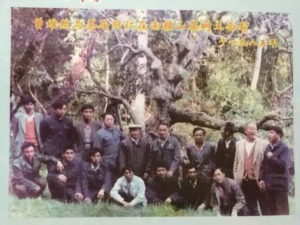Anyone who goes to Nan Nuo Shan will have heard about, or visited ‘Cha Wang Shu’, the ‘King of Tea Trees’ that is between Ban Po Lao Zhai and Ya Kou Zhai. It is estimated to be 800 years old or more, but apart from carbon dating, there appears to be no sure-fire way to tell a tea trees age as they do not have rings that can be counted in the way that most other trees do. Locally, there are only word-of-mouth assessments of age, ‘so-and-so’s grandfather says it was yea big when he was a boy’ or something akin to that. Or otherwise by comparison with a tree of known age.
Carbon dating has been used to establish the age of some tea trees. And so to the apocryphal tale of the original Nan Nuo Shan ‘Cha Wang Shu‘. It was growing a little way below Shi Tou Zhai, and had attracted a lot of interest from scientists. As early as the beginning of the 1950’s Yunnan College of Agriculture researchers were exploring the varieties of tea tree in this area. The story is that local hunters who were familiar with the area would act as guides to take researchers deep into the forest. On one such trip in late 1951 a tea tree that was 8.8 metres tall with a girth of 0.83 metres was found. A couple of years later, one Zhou Peng Ju from Yunnan Agricultural College Research Department came to examine the tree, and over the ensuing years an increasing number of botanists and specialists came to examine the tree. Eventually it was established that the tree was a cultivated variety of tea tree.
According to one version of the sequence of events, as more and more people came to visit the tree, the surrounding environment was badly affected and the tree itself was also damaged, and by the mid 1990’s the tree died.
The local version of the story is that scientists came and took samples for examination by drilling into the trunk of the tree, which lead to the death of the King of Tea Trees.
This photo, with the tea tree behind, from the famous visit in 1985, is about all the evidence that remains on Nan Nuo Shan.

